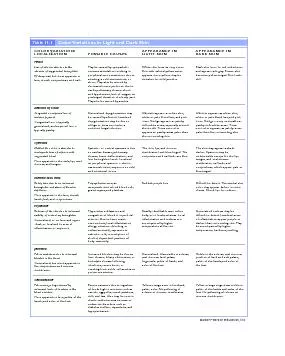/


COLOR VARIATIONAPPEARANCE IN APPEARANCE IN LOCALIZATIONPOSSIBLE CAUSESLIGHT SKINDARK SKINabsence of oxygenated hemoglobinWidespreadbut most apparent infacemouthconjunctivaeand nails Congenital ID: 161164
Download Pdf The PPT/PDF document "Skin,Hair,and Nails" is the property of its rightful owner. Permission is granted to download and print the materials on this web site for personal, non-commercial use only, and to display it on your personal computer provided you do not modify the materials and that you retain all copyright notices contained in the materials. By downloading content from our website, you accept the terms of this agreement.
Skin,Hair,and Nails COLOR VARIATION/APPEARANCE IN APPEARANCE IN LOCALIZATIONPOSSIBLE CAUSESLIGHT SKINDARK SKINabsence of oxygenated hemoglobin.Widespread,but most apparent inface,mouth,conjunctivae,and nails. Congenital or acquired loss ofCongenital loss is typicallygeneralized,and acquired loss istypically patchy. Cyanosis Color Variations in Light and Dark SkinTab May be caused by sympatheticnervous stimulation resulting insmoking,a cold environment,orstress.May also be caused bydecreased tissue perfusion due tocardiopulmonary disease,shockand hypotension,lack of oxygen,orprolonged elevation of a body part.May also be caused by anemia.Generalized depigmentation maybe caused by albinism.Localizeddepigmentation may be due tovitiligo or tinea versicolor,acommon fungal infection.to cardiac disease,pulmonarydisease,heart malformations,and ©2007 Pearson Education, Inc. Gathering the Data COLOR VARIATION/APPEARANCE IN APPEARANCE IN LOCALIZATIONPOSSIBLE CAUSESLIGHT SKINDARK SKINUremiaale yellow tone due to retention ofurinary chromogens in the blood.Generalized,if perceptible. BrownAn increase in the production and Color Variations in Light and Dark Skin(continued)Tab Chronic renal disease,in whichblood levels of nitrogenous wastesincrease.Increased melanin mayalso contribute,and anemia isusually present as well.May be due to AddisonÕs diseaseor a pituitary tumor.Localizedincrease in facial pigmentation maybe caused by hormonal changesduring pregnancy or the use ofbirth control pills.More commonlydue to exposure to ultravioletradiation from the sun or fromGeneralized pallor and yellowtinge,but does not affectconjunctivae or mucousmembranes.Skin may showWith endocrine disorders,generalbronzed skin.Hyperpigmentationin nipples,palmar creases,genitals,and pressure points.Sun exposurecauses red tinge in pale skin,andolive-toned skin tans with little orno reddening.the yellow tinge is very pale anddoes not affect conjunctivae orucous membranes.Rely onlaboratory and other data.With endocrine disorders,generaldeepening of skin tone.genitals,and pressure points.Sunexposure leads to tanning invarious degrees from brown to ssessment ofthe integumentary system includes gather-ing subjective and objective data about the skin,hair,and nails.bjective data collection occurs during the interview,beforethe actual physical assessment.The nurse will use a variety ofmmunication techniques to elicit general and specific infor-mation about the condition ofthe clientÕs skin,hair,and nails.ealth records and the results oflaboratory tests are importantsecondary sources to be reviewed and included in the data-gathering process.In physical assessment ofthe integumentarysystem,the techniques ofinspection and palpation will be used.The questions in the focused interview form part ofthe subjec-tive data and provide valuable information to meet the objec-tives related to integumentary health included in the ealthyfeature on page 229. FOCUSED INTERVIEWThe focused interview for the integumentary system concernsdata related to the structures and functions ofthat system.Sub-jective data related to the condition ofthe skin,hair,and nailsare gathered during the focused interview.The nurse must beprepared to observe the client and listen for cues related to theintegumentary system.The nurse may use closed or open-ended questions to obtain information.A number offollow-upquestions or requests for descriptions may be required to clar-ify data or gather missing information.Follow-up questions areused to identify the source ofproblems,determine the durationofdifficulties,identify measures to alleviate problems,and pro-de clues about the clientÕs knowledge ofhis or her own health.The focused interview guides the physical assessment oftheintegumentary system.The information is always considered inlation to norms and expectations about the function ofthe in-gument.Therefore,the nurse must consider age,gender,race,culture,environment,health practices,and past and concurrentproblems and therapies when forming questions and usinghniques to elicit information.In order to address all ofthefactors when conducting a focused interview,categories ofques-tions related to the status and function ofeach part ofthe in-gumentary system have been developed.These categoriesinclude general questions that are asked ofall clients;those ad-dressing illness or infection;questions related to symptoms,pain,or behaviors;those related to habits or practices;questionsthat are specific to clients according to age;those for pregnantfemales;and questions that address environmental concerns.The nurse must consider the clientÕs ability to participate inthe focused interview and physical assessment.Further,therse must consider that the appearance ofthe skin has an im-pact on self-image.A client with clear,healthy skin may have aheightened self-esteem.Clients with changes in the skin due tothe normal aging process or from skin disorders may be anx-ious about the way they appear to others.Clients with visibleskin disorders are often sensitive about the condition and theirappearance.The nurse must select communication techniquesthat demonstrate caring and preserve the dignity ofthe client. dam93732_ch11.qxd 12/7/05 6:38 AM Page 191 ©2007 Pearson Education, Inc.